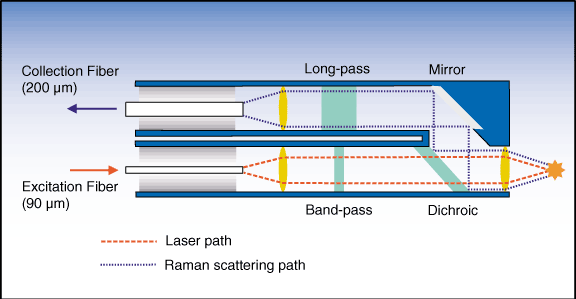Patented Optical Layout of the RamanProbeTM

Laser light is transmitted to the probe via the excitation fiber. The exciting light is collimated into the probe with a lens and then passes through a band-pass filter, which blocks any light that is not at the laser frequency (i.e. Raman scattering from the excitation fiber). The dichroic filter passes >85% of light at the laser frequency and reflects extraneous light, further "cleaning up" the excitation beam. A lens focusses the laser light to the sample, and also collects the scattered light back into the probe. The dichroic filter reflects only the Raman shifted light to the opposite side of the probe where a mirror redirects the light by 90o. A long-pass filter assembly (consisting of three filters mounted in precise alignment) effectively filters all light at and above the laser frequency (Rayleigh and anti-Stokes scattering). Another lens focusses the Raman scattered light into the collection fiber, which transmits the signal to the spectrograph. All of the above components are incorporated into a cylindrical probe only 0.5" (12.7 mm) in diameter.
The results of this design are:
- Efficient signal collection for high sensitivity
- Complete attenuation of the Rayleigh line (blocking at the laser wavelength of 108)
- Complete filtering of silica background even through 500 feet of fiber
- Precise cut on with no Rayleigh "tail" into the low frequency region
- Compact probehead offering
flexible measurement possibilities
Additionally, InPhotonics uses only the following components in its manufacturing processes:
- Hard oxide coated filters, that are resilient to humidity and temperature fluctuations (unlike holographic filters and laminated filters)
- Custom ground fused silica lenses with broadrange anti-reflective coatings
- High quality, ultra low-OH fiber for high transmission over long cable lengths
- 316 stainless-steel for the basic probe body and all immersible housings
Return to fiber optic probe overview
